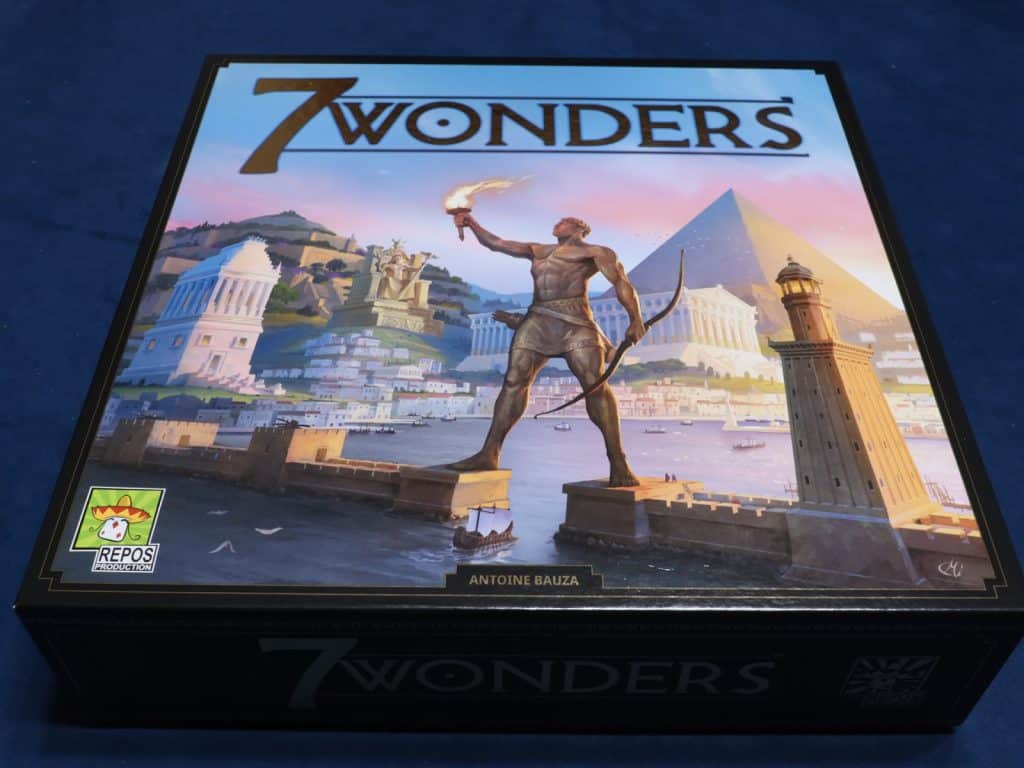
7 Wonders was a fixture of my board game shelf long before I got dedicated board game cabinets, so you can imagine my surprise when I recently discovered the existence of a 2nd edition of this iconic card drafting game. Released in 2020 to commemorate the 10 year anniversary of the game’s original release, well…suddenly I’m less surprised this slipped under the radar.
As I started to map out my 7 Wonders strategy guide, I found that 2nd edition was no mere rerelease – there were a surprising number of changes to account for when compared to my 1st edition copy. Fortunately, these adjustments aren’t significant enough to warrant dumping 1st edition copies of the game per Repos Productions, but their impact on 7 Wonders strategy proved pretty substantial.
So what all changed with this board game mainstay after 10 years? Quite a bit, as it happens.
7 Wonders Changes – An Overview
The following aspects of 7 Wonders were revised for 2nd edition:
- The box and several in-game components
- Available buildings and building chains found in the Age decks
- Most Wonders received multiple adjustments, primarily focusing on the resources needed to build them
- Olympia’s Wonder was completely overhauled
While the actual flow and rules of gameplay were left intact, 2nd edition almost looks like a completely different game inside and out. I wouldn’t have believed how different this familiar game looked until I bought a new 2nd edition copy so I could see for myself.
Now that I have physical copies of both games, I’m going to review every change I can find between the two editions of 7 Wonders and see how they compare to one another. There’s only room for one version of this classic in my game room, so may the better game win.
7 Wonders Box and Component Updates

- The 2nd edition box is roughly 1/2 inch longer and wider, plus uses different art
- The military conflict tokens have been updated
- You receive 2 more -1 military conflict tokens and 8 more value 1 coins
- The Wonder boards are larger
- The Wonder cards have been removed
- The card faces are arranged differently
- The card backs are differently colored
- The 2-Player variant & cards to play this variant have been removed
- The rulebook and inserts have been updated and simplified to make gameplay easier to understand
While the majority of these changes are cosmetic in nature, in the interest of being thorough, I wanted to list them all out for anyone who was curious.
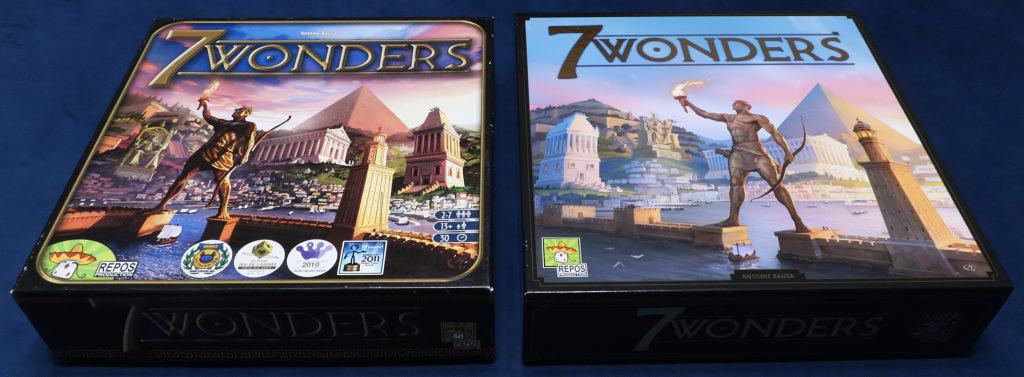
The 2nd edition printing of 7 Wonders leans into a more metallic look in some areas of its presentation, including both the text on the box exterior and the backs of the cards found within the Age decks. While this looks cool on the cards and box in well-lit gaming spaces, it does make them harder to read in low or indirect lighting, which is unfortunate for those with poor eyesight like me.
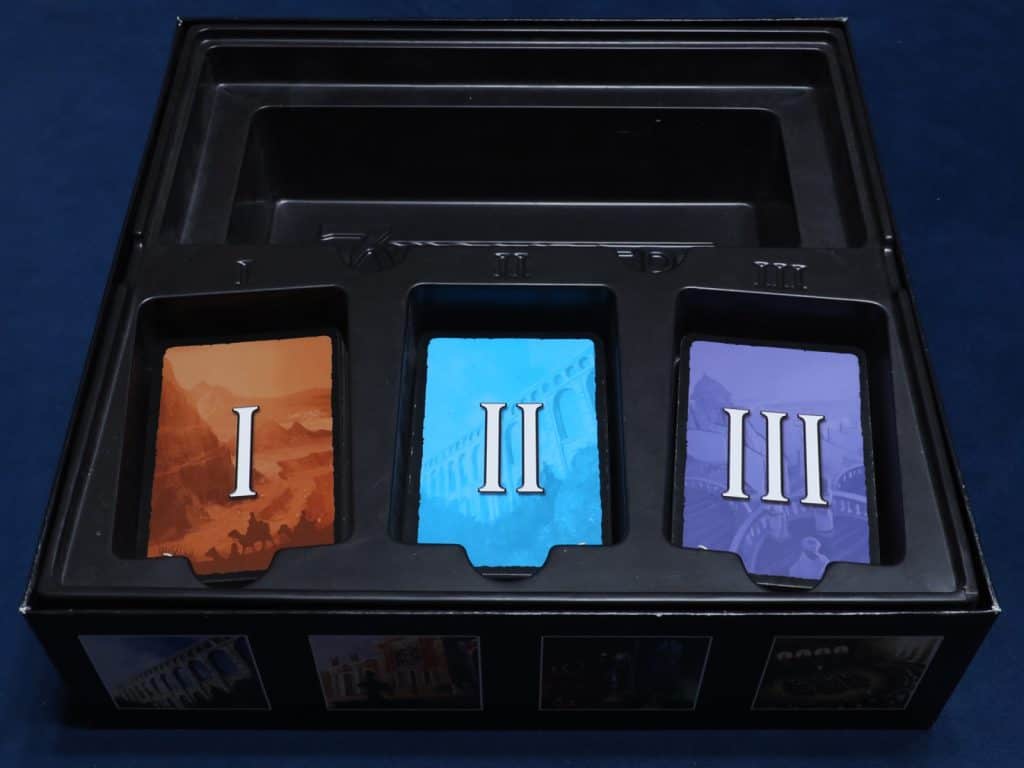
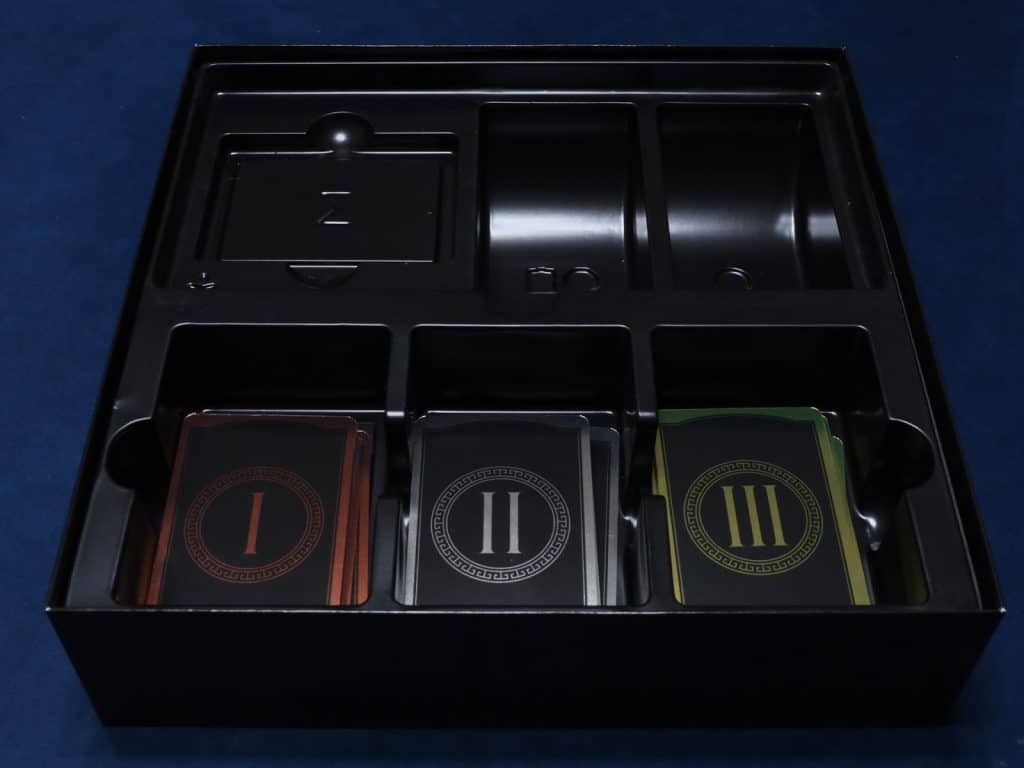
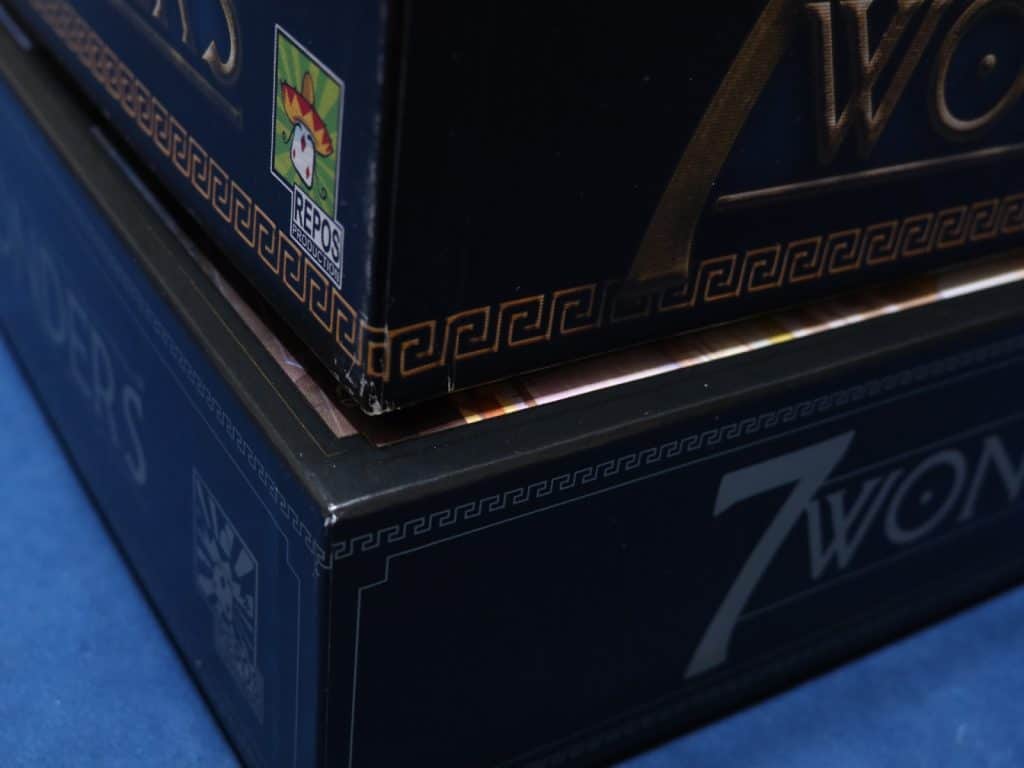
This presentation issue is likely to be overlooked by those who enjoy their board game boxes being similarly sized, however. An extra (approximate) half-inch has been added to the length and width of the newer 2nd edition box when compared to 1st edition, putting the box size in line with games like Ticket to Ride and Dead of Winter.
A few extra military tokens and coins were included with the 2nd edition game as well, but the real winner when it comes to game component updates are the Wonder boards. These boards are considerably larger than 1st edition’s, allowing you to appreciate the artwork and see the relevant game information more easily from a distance.
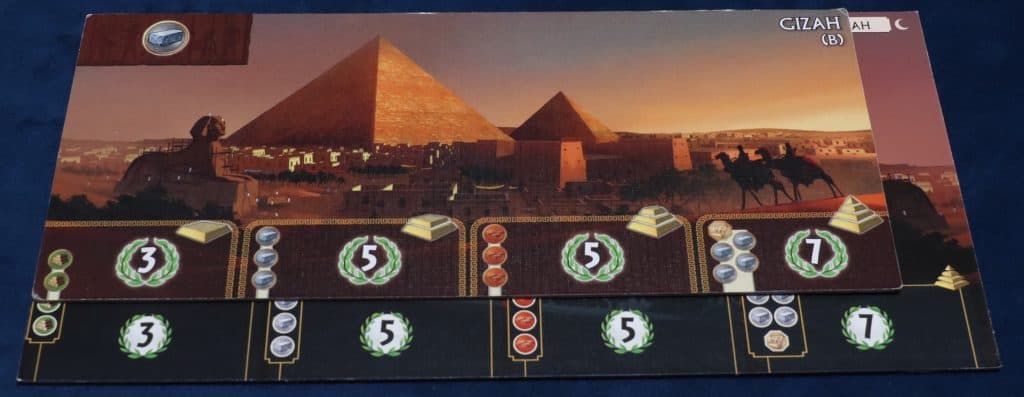
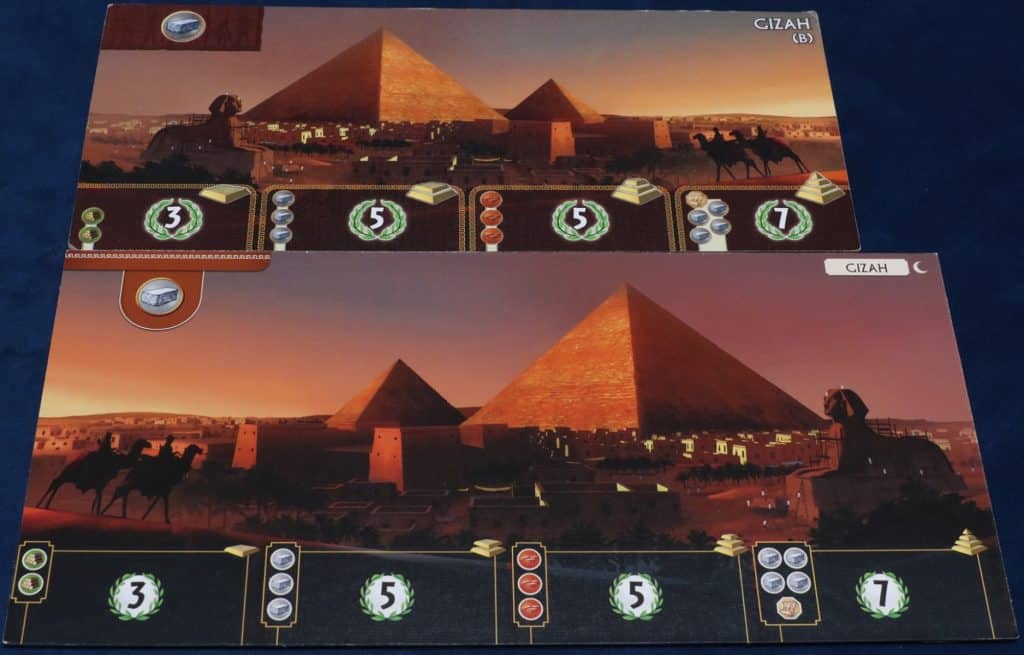
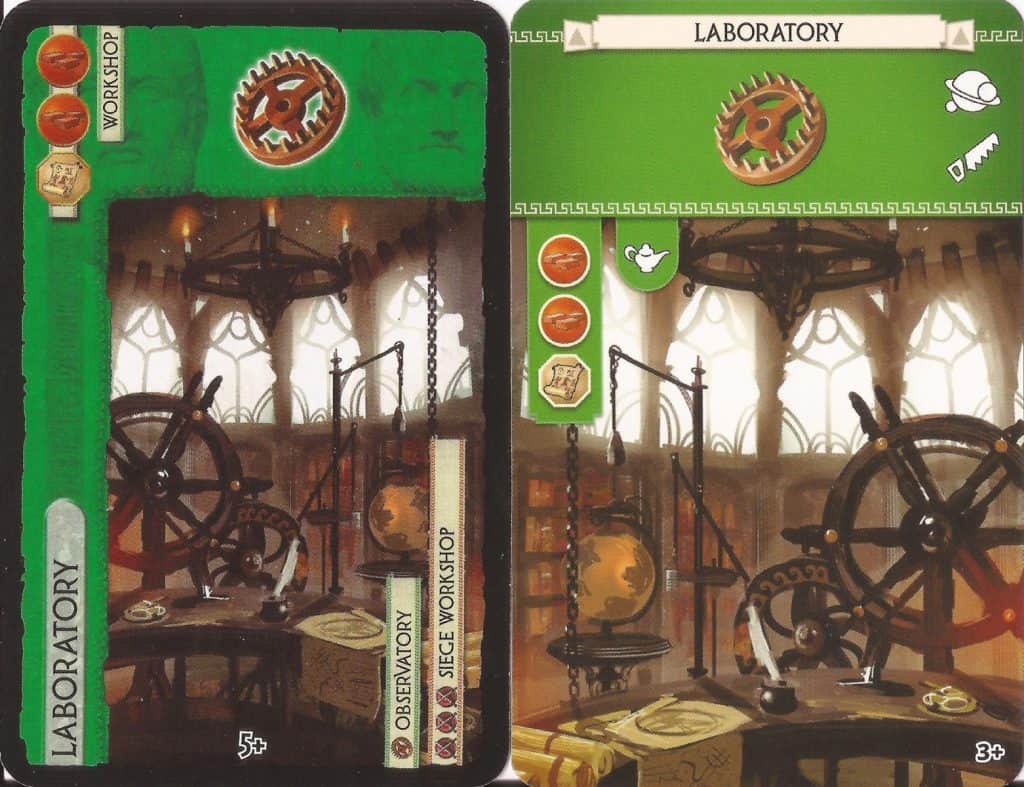
Card layout has been updated to also reflect this emphasis on art. Gone are the black borders of 1st edition, replaced by borderless counterparts that make use of every square centimeter on the card fronts. Building chains have also been updated to use matching symbols instead of building names, as pictured on the Laboratory cards here.
This simplification of rules presentation actually extends to the entirely of the 7 Wonders 2nd edition rulebook. Information is impeccably organized, and there are separate inserts that showcase building chains and what card and wonder symbols mean so multiple people can reference specific elements of gameplay simultaneously.
The primary omission from 1st edition’s rulebook is of course the 2-player gameplay variant, but honestly, this isn’t a big loss. 2 player variants of card drafting games like Bunny Kingdom and 7 Wonders are somewhat clunky and convoluted in design because card drafting games designed for group play simply flow better with at least 3 people.
That said, this flaw can easily be worked around by specifically designing for a 2-player experience, and that’s where 7 Wonders: Duel comes in. It delivers stellar 2-player gameplay that simply wasn’t available when 7 Wonders was first released in 2010, and is the definitive 2 player 7 Wonders game at this point in time.
With a far superior 2-player alternative readily available, I am completely okay with 7 Wonders being rebranded as a 3-7 player game, as it just makes for a better experience for all involved.
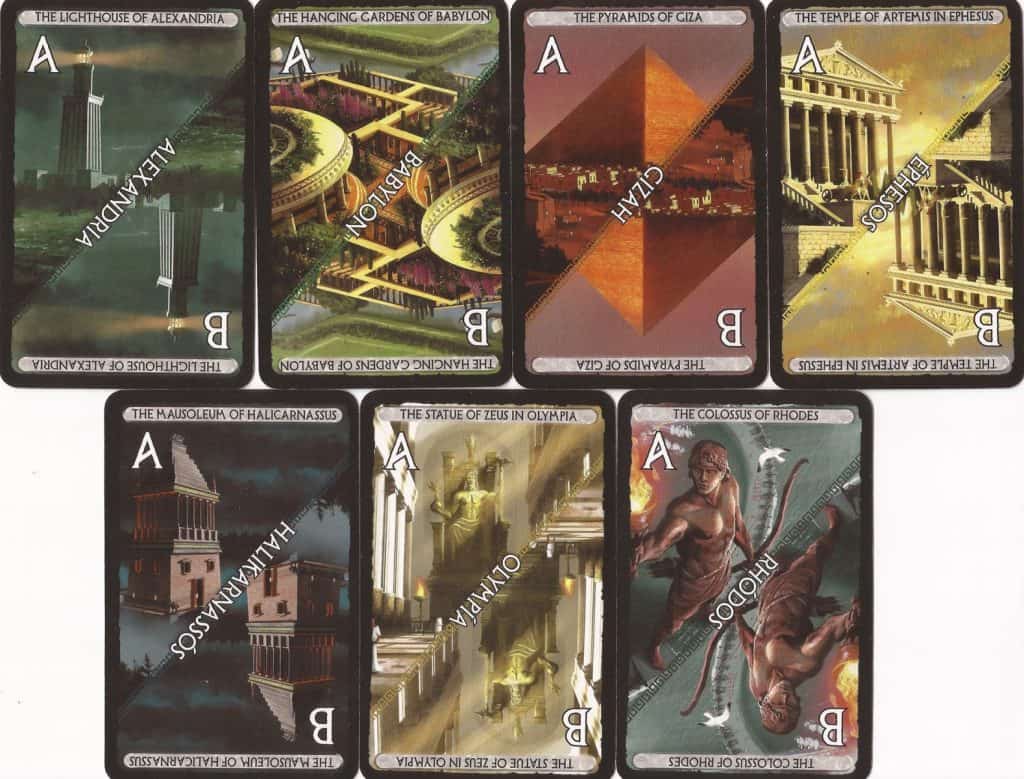
As happy as I am with this change, however, I’m similarly unhappy seeing the removal of the Wonder cards from 2nd edition.
These were great for randomizing Wonder distribution, and there was no real benefit to be gained by taking these out. I guess we can roll for Wonders using a d8, but then I’ll also have to roll again if I want to randomly choose the side I’m playing.
While this won’t be a hurdle for many, it needlessly complicates a setup step that was so elegantly solved the first time around.
7 Wonders Building Changes
1st Age
- The Altar and Theater now score 3 points each instead of 2
- The Pawnshop was changed to the Well
- The Altar now builds into the Pantheon of the 3rd Age, removing the 2nd Age Temple from the building chain
- The Theater now builds into the Gardens of the 3rd Age, removing the 2nd Age Statue from its building chain
- The Well now builds into the Statue in the 2nd Age
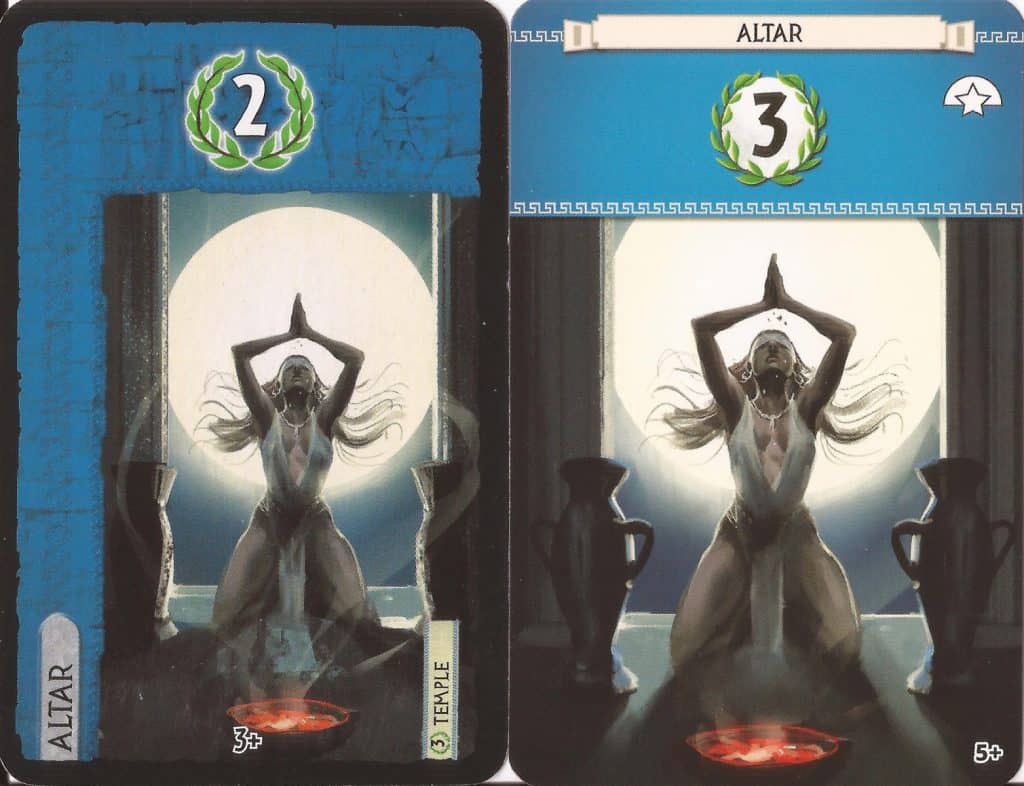
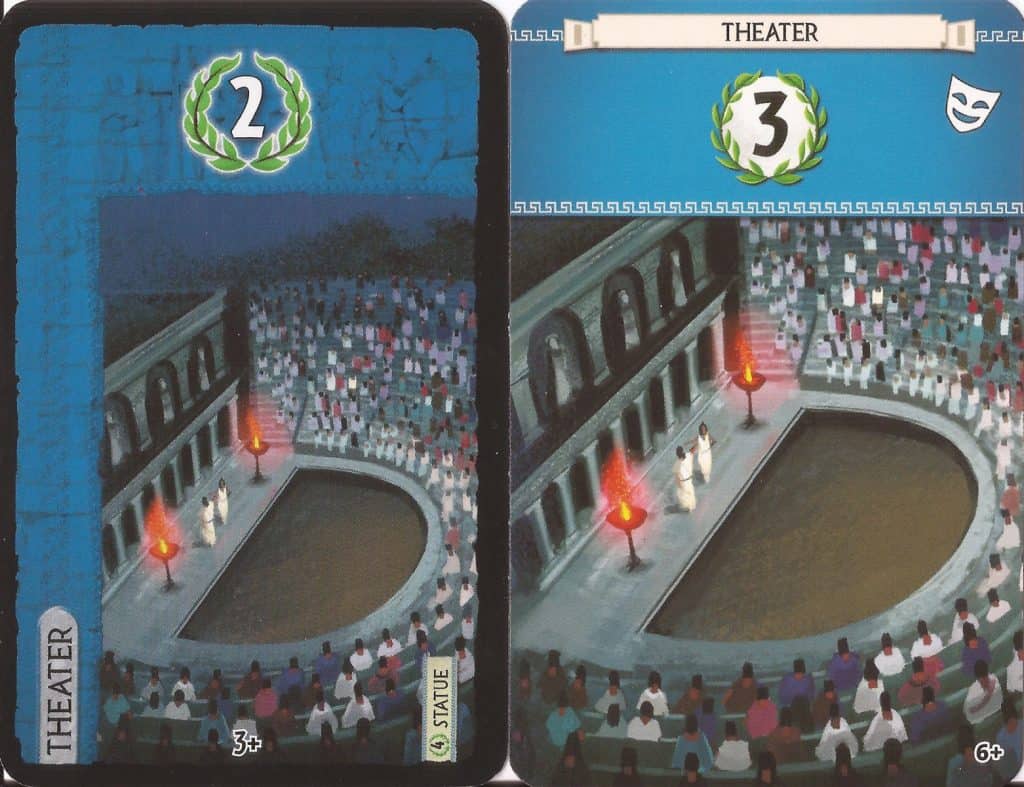
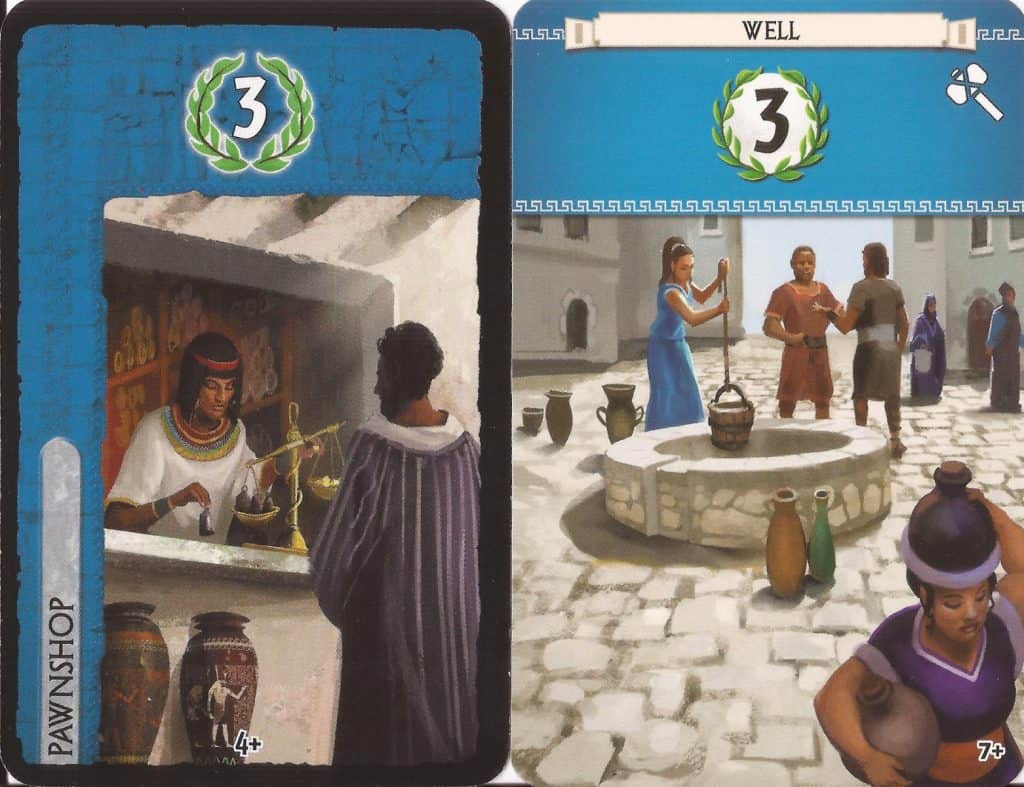
All the 1st Age revisions revolve around the civilian structures (point cards). Underpowered cards like the Altar and Theater received a scoring buff, and the Pawnshop was removed entirely, being replaced with the Well.
The Well serves as a renaming for most intents and purposes. Its cards are still used in 4+ and 7+ player games, but unlike the Pantheon, the Well actually serves as a precursor to the Statue in the 2nd Age, giving it a slight edge over its predecessor.
This change was able to be achieved by simplifying building chains for civilian structures overall, giving each building in the 1st Age only 1 upgrade to a more potent point card in the 2nd or 3rd Ages, instead of ranging from 0-2.
Thanks to this adjustment, every point card in the 1st Age now has at least some value. 2 point cards were almost always the dregs of the table in 1st edition, and now you not only don’t have to worry about them, but know that all of them will let you snag a later point card resource-free.
Adding this consistency during the foundation round of 7 Wonders also serves to create a better experience for first time players. Point cards are as easy to understand as it gets, so they’re often popular picks for newbies.
Buffing them encourages education on one of the more complex mechanics of the game (building chains), teaches them to look out for certain cards and form strategies for later rounds, and helps them feel a little less outmatched by the veterans at the table because they can easily see how many points they have.
Nothing but kudos here, these were all smart revisions.
2nd Age
- The Temple now scores 4 points instead of 3
- The Temple is no longer part of a building chain
- The Statue’s precursor is now the Well instead of the Theater
- The Statue is no longer a precursor for any building
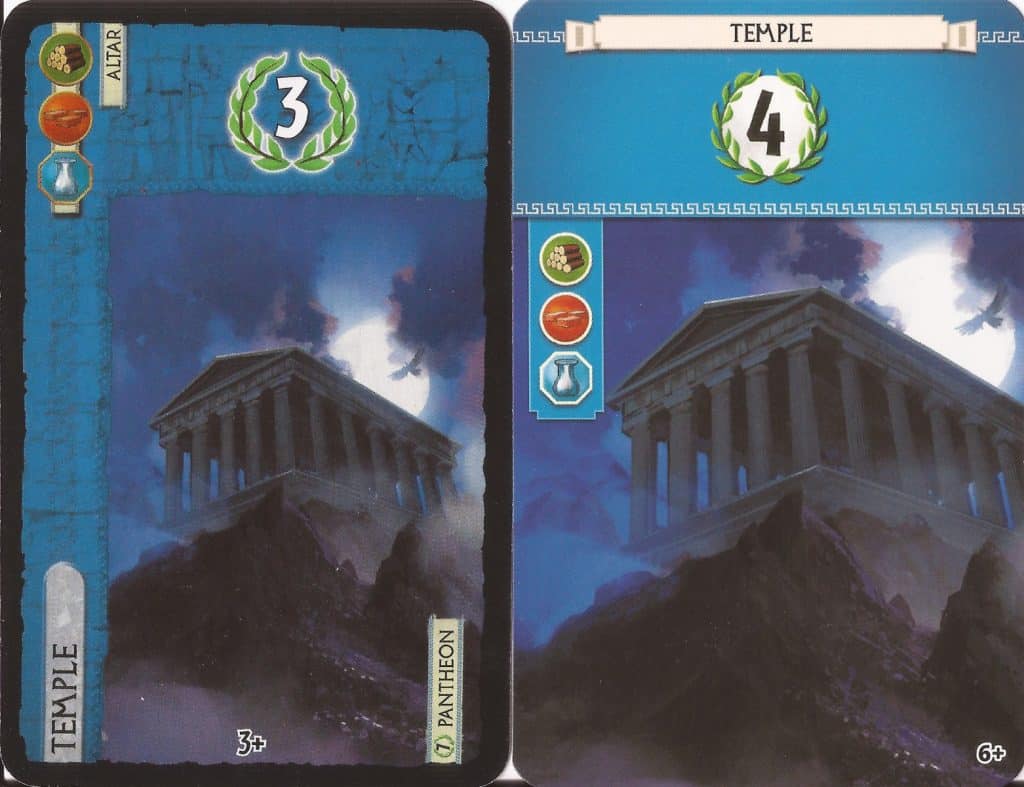
This is another change meant to buff an underpowered point card, meaning the worst point card in the 2nd Age now scores 4 points alongside the Statue and Courthouse.
The Temple’s removal from its building chain is another change of note here, and one that I’m not convinced is for the better. The Temple is now the only 2nd Age point card that has no tie in with any other buildings, past or future, which sends a weird message to drafters after the 1st Age’s polish.
Why this couldn’t have been a precursor for the Town Hall or an identically renamed point card is beyond me. It wouldn’t have messed with any of the previously established synergy and would have left the Palace, the most valuable civilian structure, as the only building without a building chain, which would have made sense as it is the most valuable.
3rd Age
- The Strategists Guild was replaced by the Decorators Guild
- The cost to build the Builders Guild was increased by 1 stone
- The cost to build the Spies Guild was reduced by 1 clay
- The 5+ Town Hall and 7+ Arena were replaced by the new Ludus cards
- 80% of the Military cards of this Age were involved in a rebalancing, including the addition of a new building, the Castrum
- The precursor building for the Pantheon changed from the Temple (2nd Age) to the Altar (1st Age)
- The precursor building for the Gardens changed from the Statue (2nd Age) to the Theater (1st Age)
Wow, there is a LOT to unpack here. The 3rd Age deck received the most revisions by FAR of the 3 Age decks, with an emphasis on balancing guilds and buffing military strategies. I’ve already covered the point card changes in earlier sections, so let’s start with a look at the Guild changes.
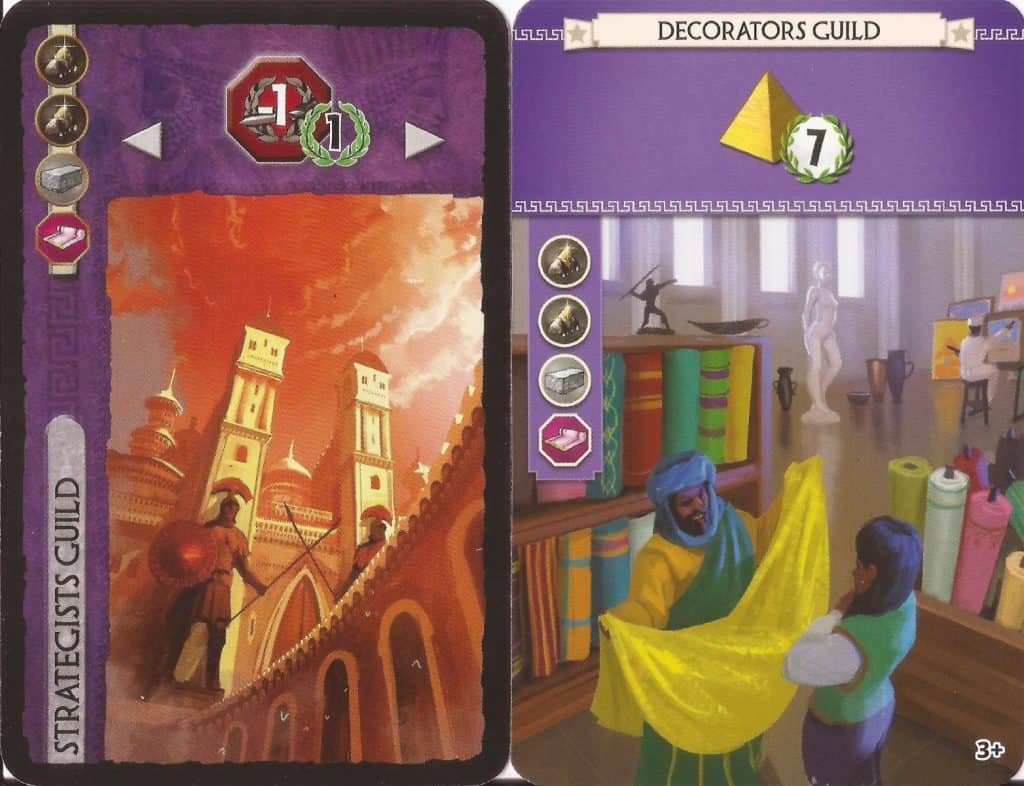
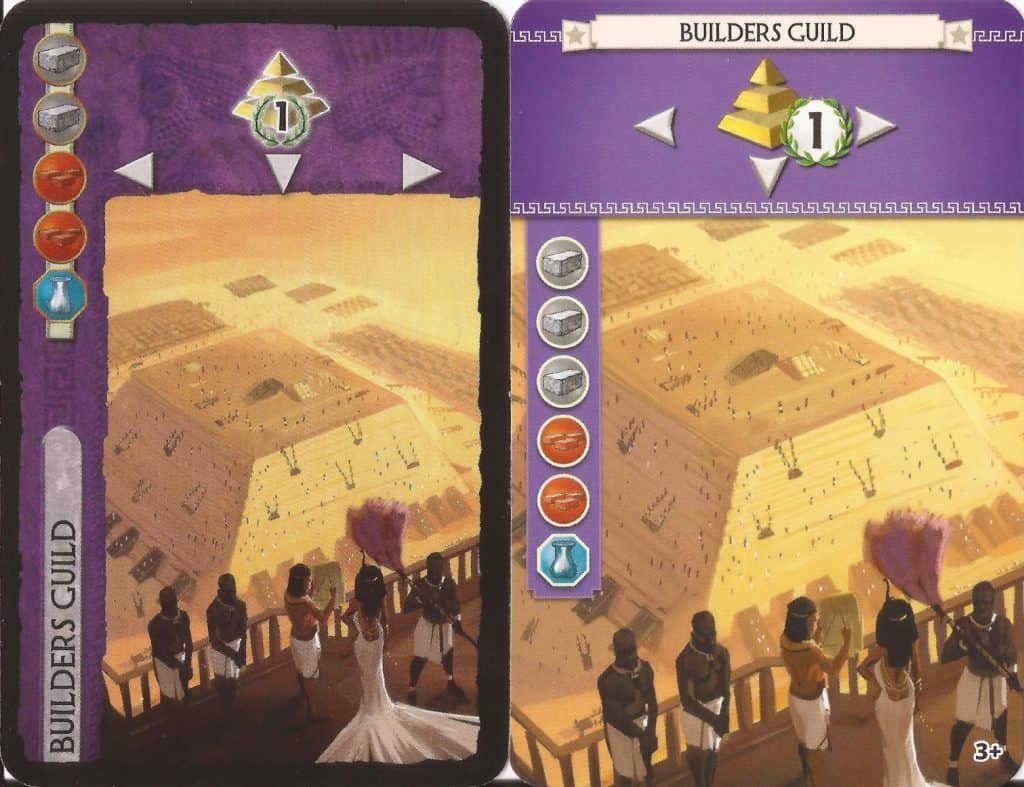
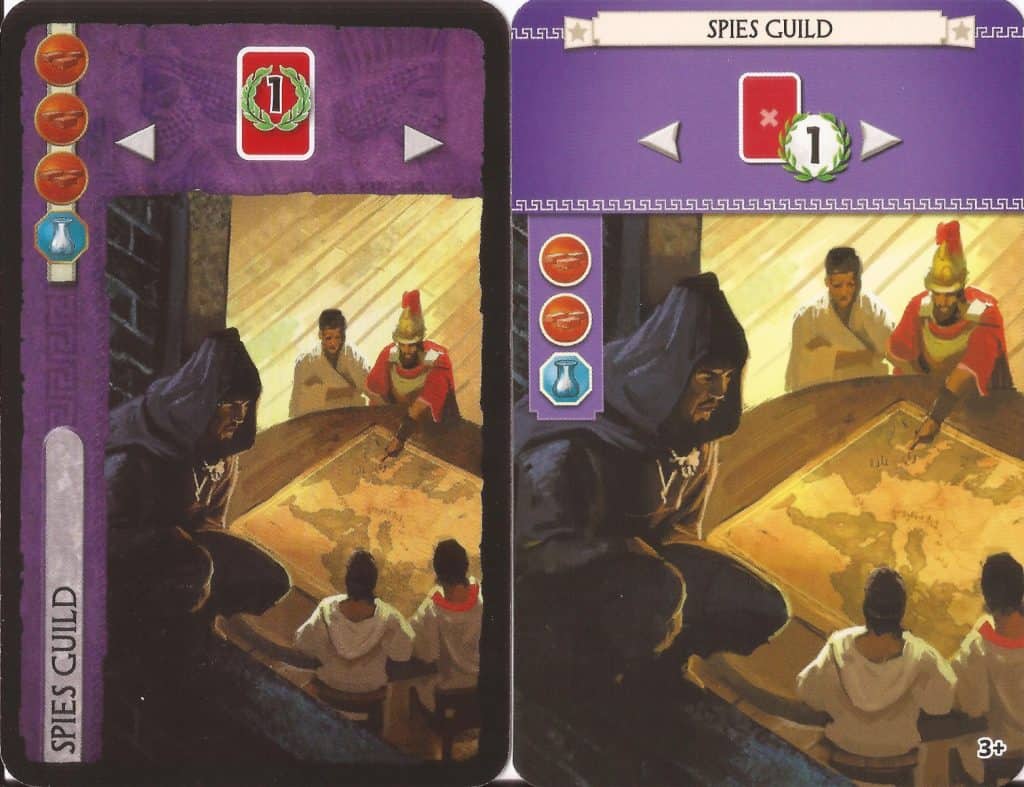
The replacement of the Strategists Guild is easily the biggest change among these 3 adjustments. While I don’t like the removal of a military support card, I don’t think there was any way this guild could have been reasonably adjusted as it was.
Changing it to include yourself would have given it a needed point buff, but made no sense in context. Raising the earned points from 1 to 2 would have made it unreasonably strong for someone running a dedicated military strategy, reducing the need for them to balance it with a 2nd game plan.
By process of elimination, removing it was really the only viable option if the Strategists Guild was considered underpowered, and to be frank, it was when compared to other guilds.
Ordinarily, I would be annoyed by the addition of another card that rewards building your Wonder, as most already incentivize you to build them ASAP, but as we’ll be discussing later on, Wonders are considerably harder to build in 2nd edition. A little extra reward for jumping through the new hoops actually seems warranted as a result.
Factor in the removal of an Arena (don’t worry, there’s still 2 of each), and it actually makes sense and preserves balance.
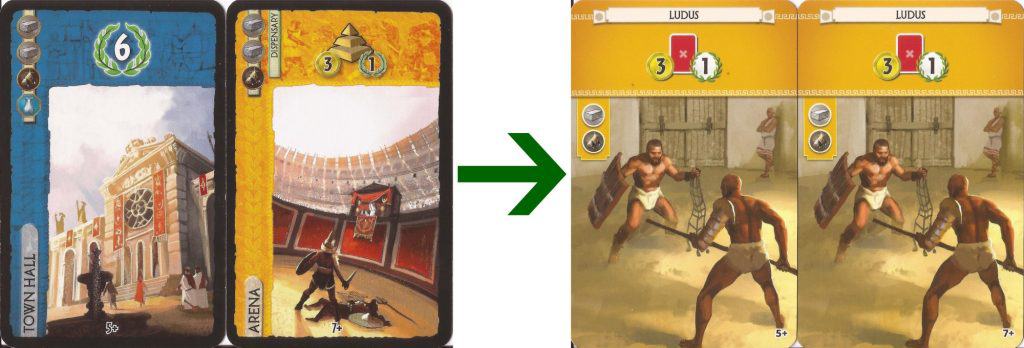
The Ludus is both a welcome and overdue card to support military strategies in 7 Wonders. Inexpensive to build, particularly for a 3rd Age card, it can actually generate a silly amount of value if you were forced into picking up 5-6 military cards earlier in the game.
Picking up 12-18 coins is actually enough money to either buy you out of resource troubles, which is often something military-focused players struggle with. If you did a good job of balancing your card selection early, the money can also generate reasonable points when paired with the guaranteed endgame military points.
These perks put the Ludus on par with many guilds in terms of power – it’s just a shame you need a minimum of 5 players for one to be available in the 3rd Age deck.

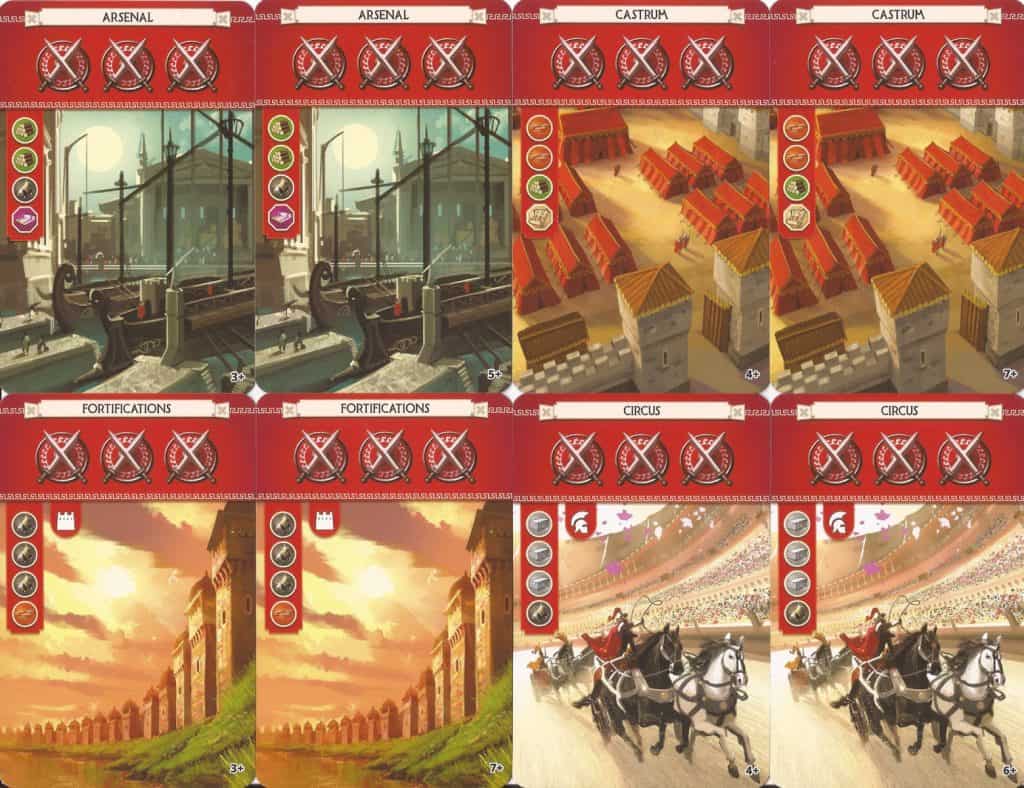
The military cards really need their own subsection to describe all the changes they received, so here they are:
- One Arsenal card was removed, and its cards went from being in 3+, 4+, and 7+ decks to 3+ and 5+ decks
- The cost of the Fortification was changed from 3 ore and 1 stone to 3 ore and 1 clay
- The 5+ Circus card was removed
- The Castrum was added for 4+ and 7+ decks
Military cards of the 3rd Age in 1st edition suffered from heavy duplication. I can’t count the number of times I’ve had to concede a military conflict because I was handed 1-2 copies of a military card I built early, then had to pass to my neighbor.
Sure, you can sell them or build your Wonder with them, but selling a card in the 3rd Age is almost always the worst play you can make, and my Wonder is almost always fully built before this point in the game, making this scenario extra frustrating.
With 2nd edition’s release, there are now 2 copies each of 5 unique military cards, which dramatically cuts down on the odds of seeing duplicate cards. This is actually a theme across several different card types during the 3rd Age, which explains the other card changes for this deck and creates a better mix of cards overall.
Building Chains
There isn’t much more to discuss that wasn’t covered during the “patch notes” of the 3 Age decks, but I did want to draw attention to 2nd edition’s use of symbols to identify building chains.
Unlike 1st edition, which used precursor building names next to the cost of a card and upcoming building names in the lower right corner, 2nd edition omits these for symbols next to the cost or in the upper right corner of a card instead.
I’m of the opinion you could also have put the names of the cards with these symbols, particularly since 2nd edition created more card space by removing the black borders found on 1st edition cards, but in the grand scheme of things, this is a relatively small complaint.
For those who prefer comparing changes visually instead of reading them, I have enclosed both building chain charts below.
7 Wonders Wonder Changes
For more in-depth strategy discussion or simply a look at all the boards, I recommend checking out my full 7 Wonders strategy guide. In it, I review the strategic potential of all Wonders and go far more in-depth when talking about the potential of both sides of the 1st and 2nd edition boards.
For this discussion, however, I’ll just be focusing on the changes between boards. The A side from 1st edition and Day side from 2nd edition will be referred to as the front of a board moving forward, and B side and Night side will be referred to as the reverse side.
2nd edition’s boards will also appear a little larger to showcase the difference in board size between 1st and 2nd edition. You can also see pictures of this difference in the box and component discussion from earlier.
The Lighthouse of Alexandria
- The front side’s 3rd stage is built with a papyrus and loom instead of 2 glass
- The reverse side’s 2nd stage is built with 3 ore instead of 2 wood
- The reverse side’s 3rd stage is built with 4 wood instead of 3 stone
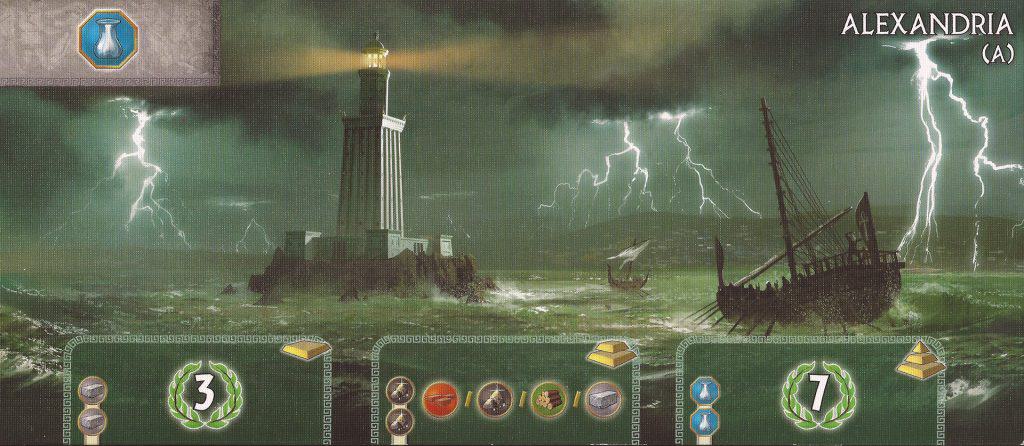
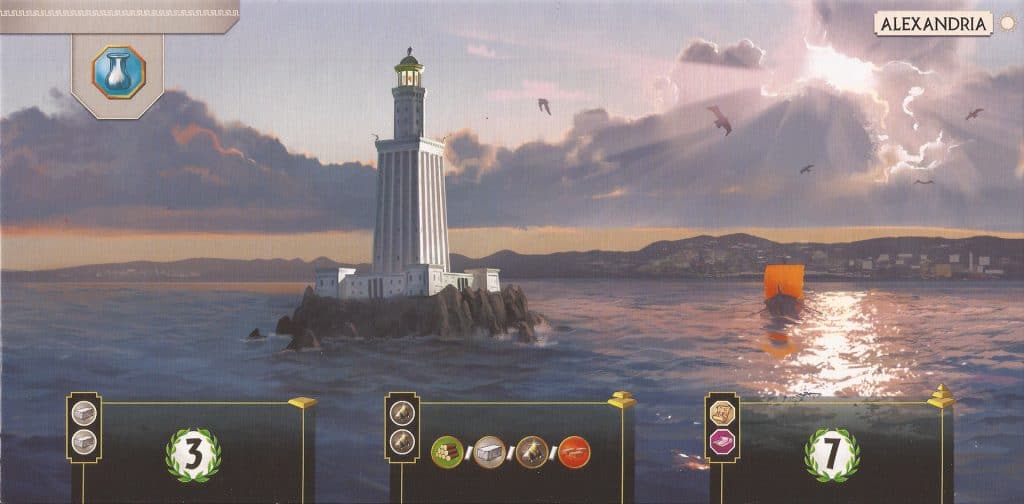
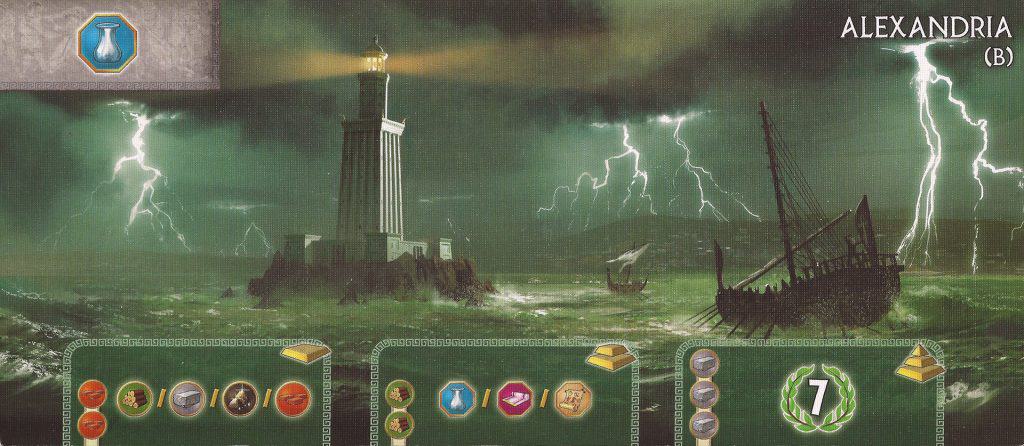
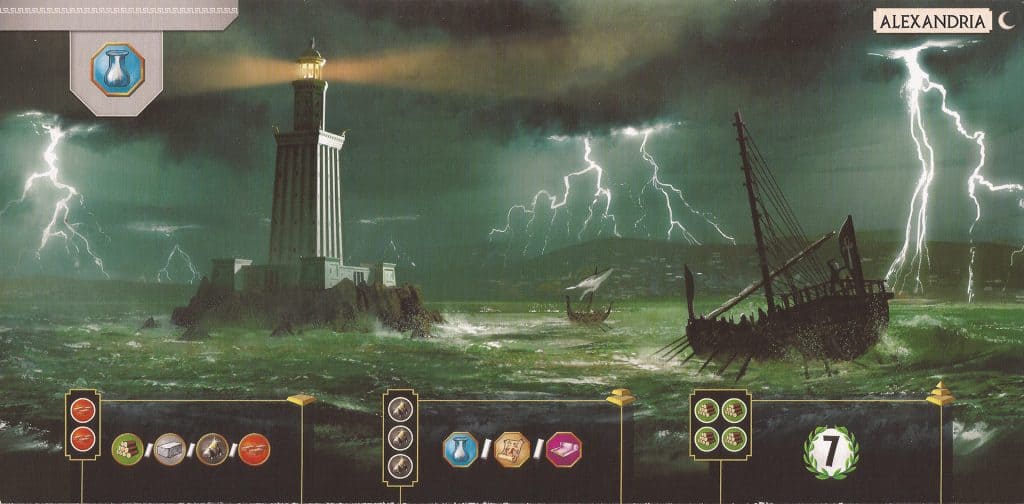
I never noticed this before, but Alexandria’s 1st edition front side arranges the raw materials differently from both its reverse side and 2nd edition. No impact on the effect, it’s just weird.
These changes were all designed to slow Alexandria down, as it was way too easy to rush it to completion during the 1st Age, then bury your opponents with the extra resources from there. Still an excellent Wonder overall, just considerably more fair than it was.
The Hanging Gardens of Babylon
- Babylon now produces wood instead of clay
- The front side’s 2nd stage now costs 2 ore and a loom instead of 3 wood
- The front side’s 3rd stage now costs 4 wood instead of 4 clay
- The reverse side’s 1st stage has been removed
- The reverse side’s “middle” stage now costs 2 stone instead of 2 wood and a glass
- The reverse side’s “last” stage now costs 3 clay and a glass instead of 3 clay and a papyrus
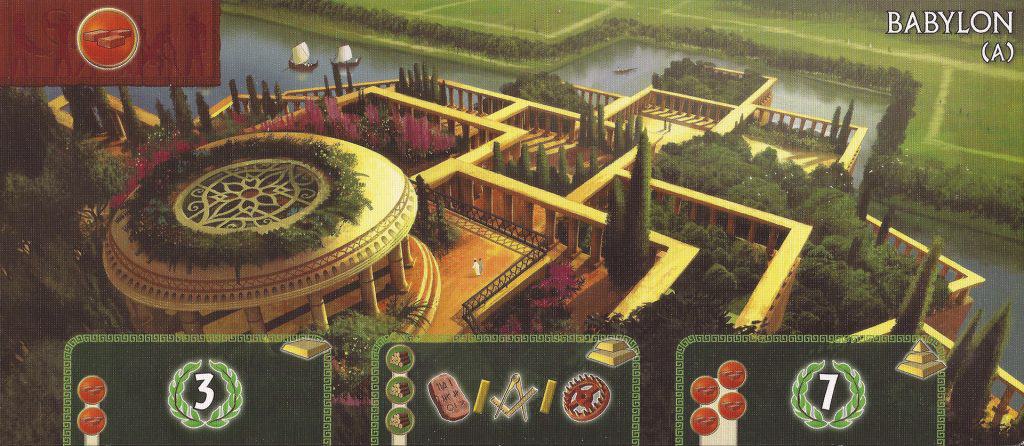
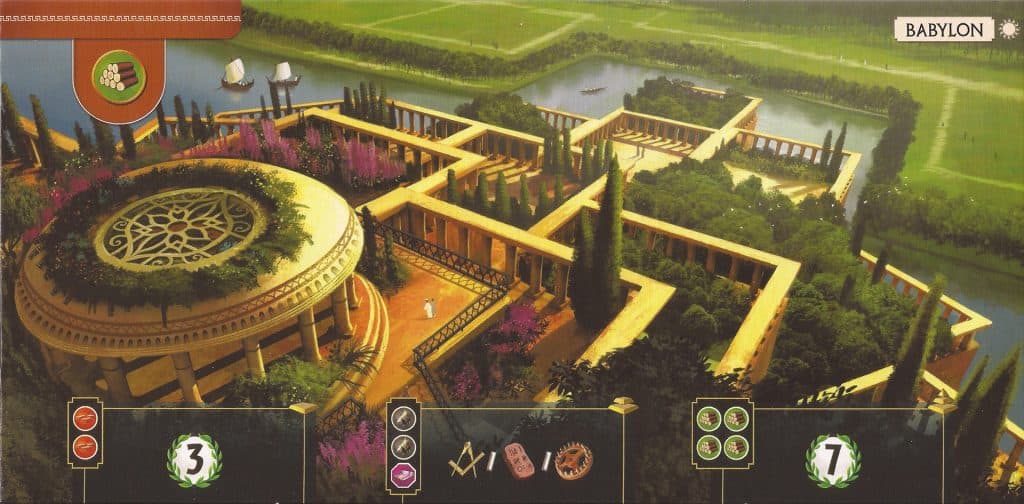
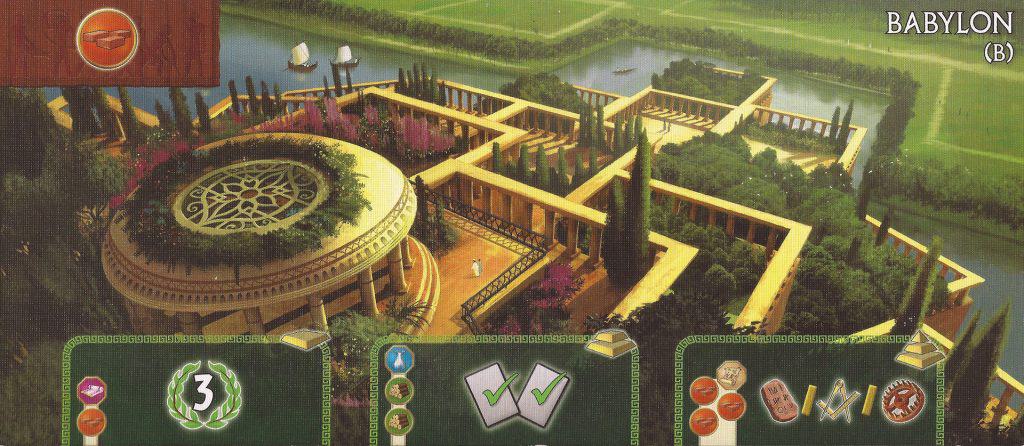

Babylon’s changes are pretty interesting. The immediate takeaway is that the game designers wanted to slow the ability for you to fully build this wonder, but it isn’t by terribly much when you think about it. If you’re leaning heavily into science cards, a loom and a glass are basically required resources, so these changes really just reinforce the intended focus of Babylon.
The reverse side removing its first wonder stage in 2nd edition is definitely a positive change, as it allows you very easy access to Babylon’s critically important ability to take the last 2 cards of a round instead of just the sixth. 2nd edition’s reduced cost is simply icing on an already delicious cake.
The Temple of Artemis in Ephesus
- The front side’s 1st stage now costs 2 clay instead of 2 stone
- The front side’s 3rd stage now costs 2 ore and a glass instead of 2 papyrus
- The reverse side’s 3rd stage now costs 2 ore and a loom instead of a papyrus, a loom, and a glass
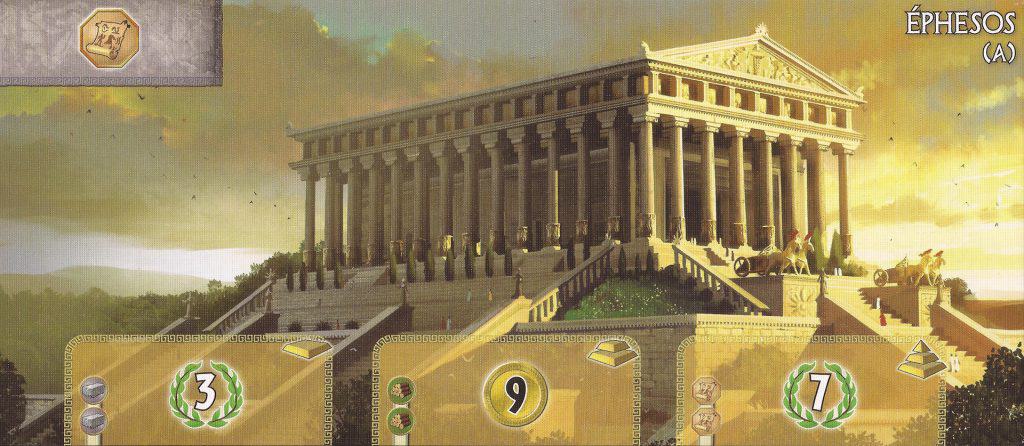
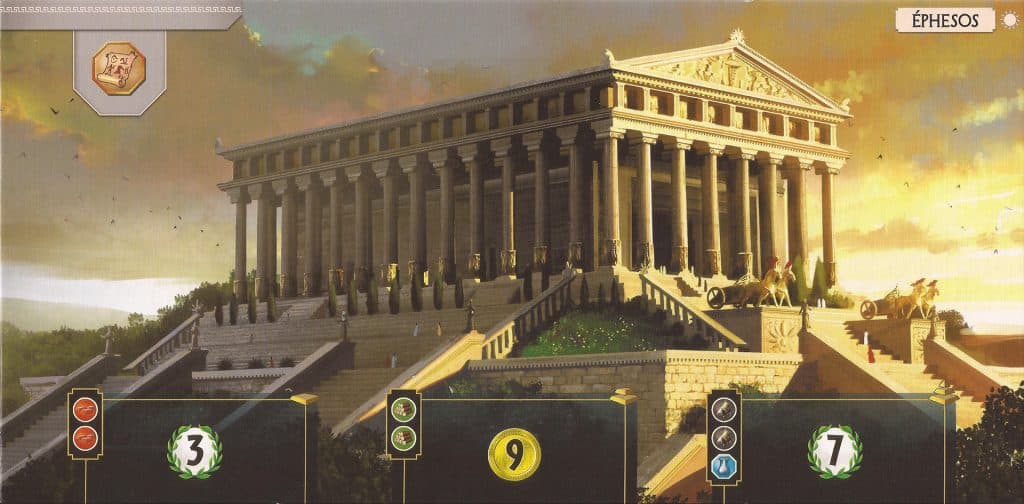
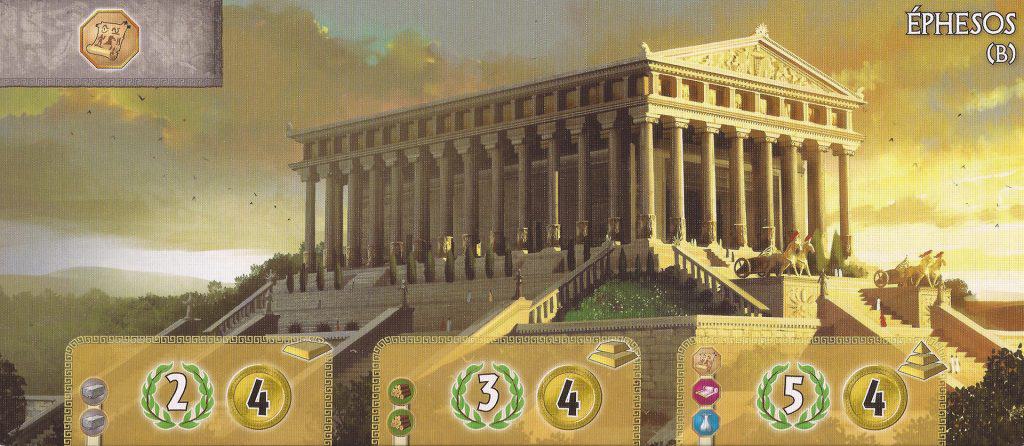
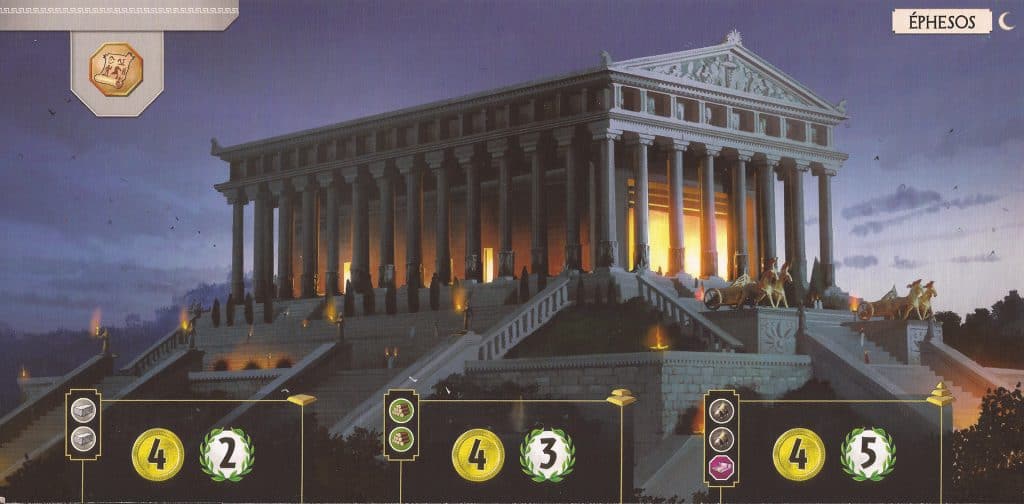
Ephesus, on the other hand, really got hit with the nerf bat for 2nd edition, and I cannot think of a good reason for this. Relatively easy access to building this Wonder was really all the original version of Ephesus had going for it.
Sure, coins are nice for smoothing out poor card selection and/or drafting errors, but they aren’t worth much point-wise at the end of the game. At least you don’t need access to all 3 manufactured resources for the reverse side, so I guess that’s something.
The Pyramids of Giza
- The front side’s 1st stage now costs 2 wood instead of 2 stone
- The front side’s 2nd stage now costs 2 clay and a loom instead of 3 wood
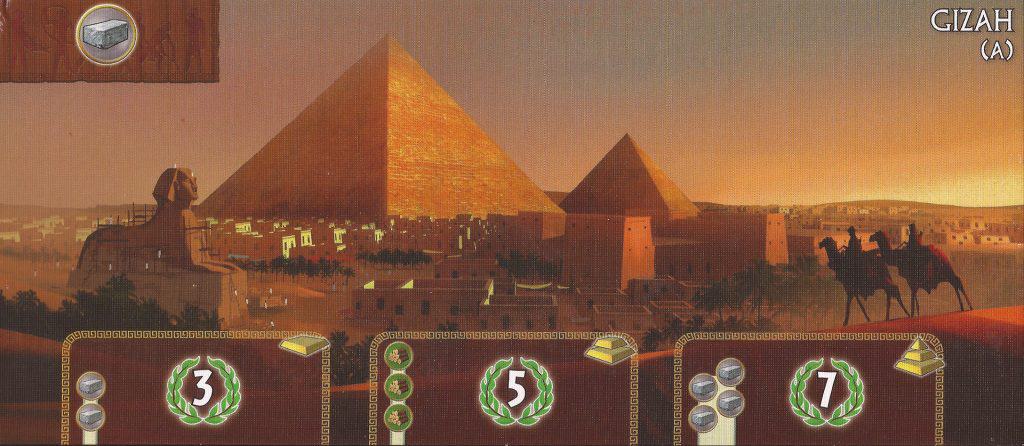
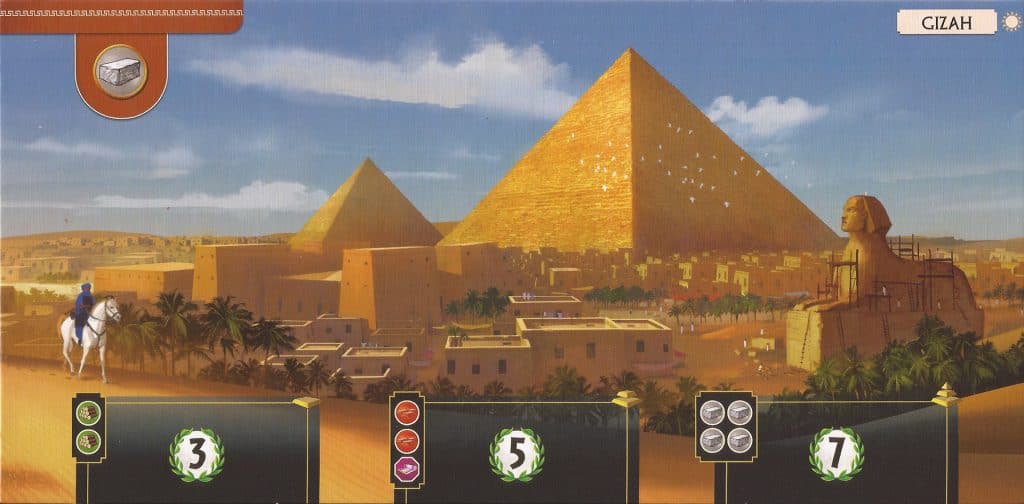
Giza’s front side synergized with its generated resource really well in 1st edition, so I get why it was slowed down in the revision. None of the new requirements are unreasonable, and actually encourage you to gather plenty of raw materials, which is simply a good rule of thumb for 7 Wonders anyway.
The Mausoleum of Halicarnassus
- The front side’s 1st stage now costs 2 ore instead of 2 clay
- The front side’s 2nd stage now costs a glass and a papyrus instead of 3 ore
- The front side’s 3rd stage now costs 3 stone instead of 2 looms
- The reverse side’s 1st stage costs 2 clay instead of 2 ore
- The reverse side’s 2nd stage costs a glass and a papyrus instead of 3 clay
- The reverse side’s 3rd stage now costs 3 wood instead of a glass, a papyrus, and a loom

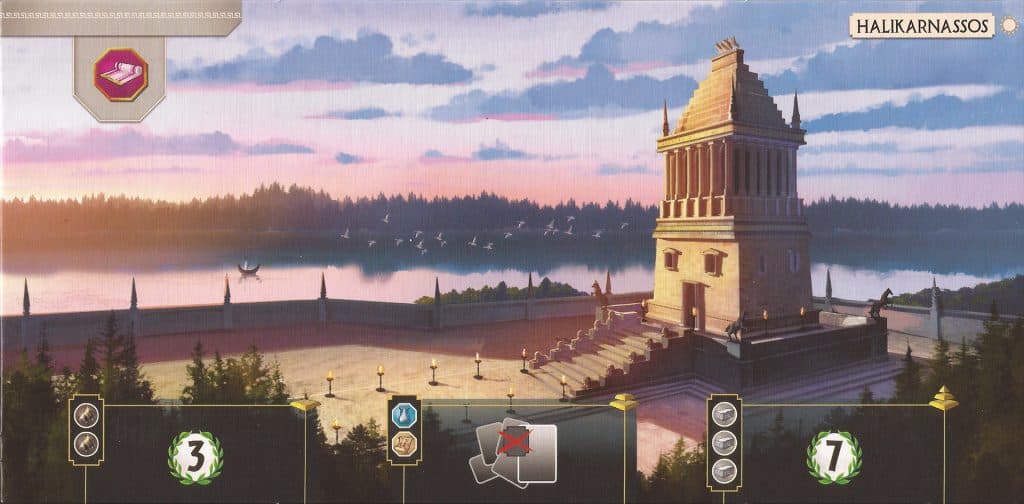
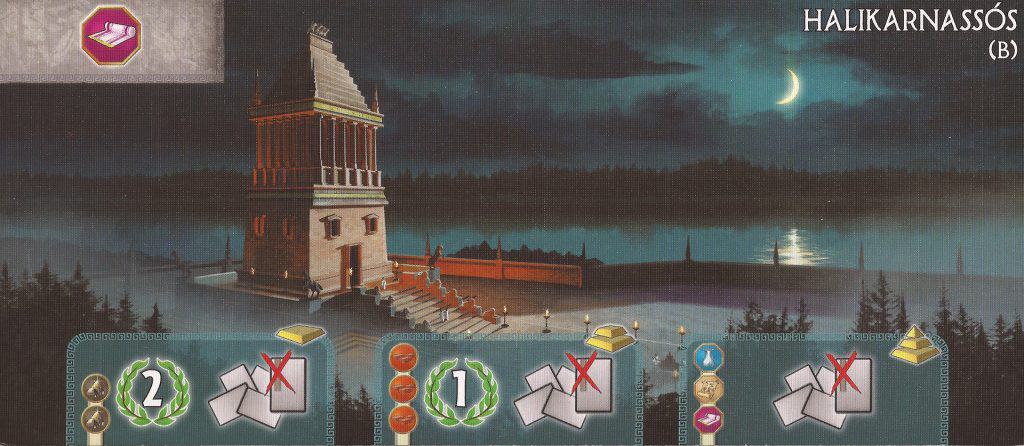

Despite all these changes, the majority of them basically represent a lateral move if you intend to fully build Halicarnassus. The manufactured good requirement is pushed up to 2nd stage from 3rd stage, and the front side is made harder to build with its adjustments, but only slightly so.
I suspect these changes were more presentation oriented, as the new order of resource requirements to build Halicarnassus actually looks like it becomes more difficult to build as you progress, rather than easy, difficult, then slightly difficult as it was originally.
The Statue of Zeus in Olympia
- Olympia now produces clay instead of wood
- The front side’s 1st stage now costs 2 stone instead of 2 wood
- The front side’s 2nd stage allows you to build the first card of each unique color in your city for free instead of 1 card of your choice each Age
- The front side’s 2nd stage now costs 2 wood instead of 2 ore
- The front side’s 3rd stage now costs 3 clay instead of 2 iron
- The reverse side’s 1st stage now lets you build the 1st card of each Age for free and gives 2 points instead of reducing trade costs of raw materials from your neighbors
- The reverse side’s 1st stage now costs 2 ore instead of 2 wood
- The reverse side’s 2nd stage now lets you build the last card of each Age for free and awards 3 points instead of 5
- The reverse side’s 2nd stage now costs 3 clay instead of 2 stone
- The reverse side’s 3rd stage awards 5 points instead of copying a neighbor’s guild card at the end of the game
- The reverse side’s 3rd stage now costs a glass, a papyrus, and a loom instead of a loom and 2 ore
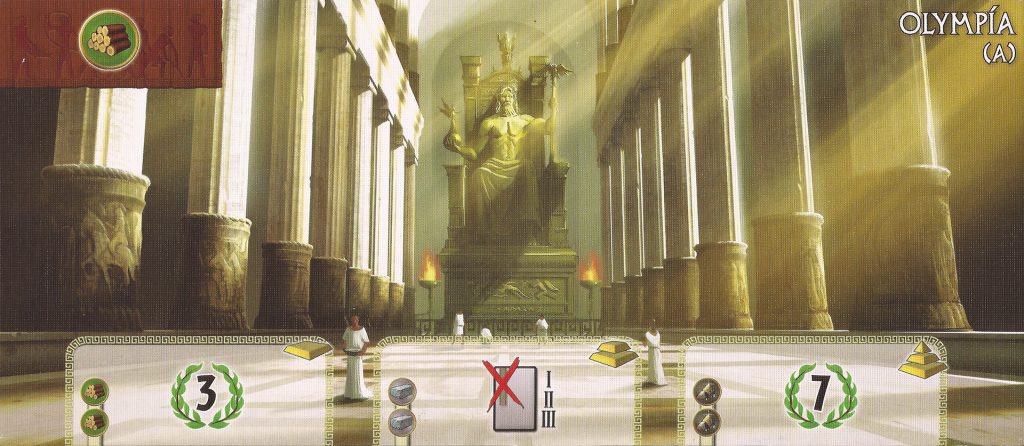
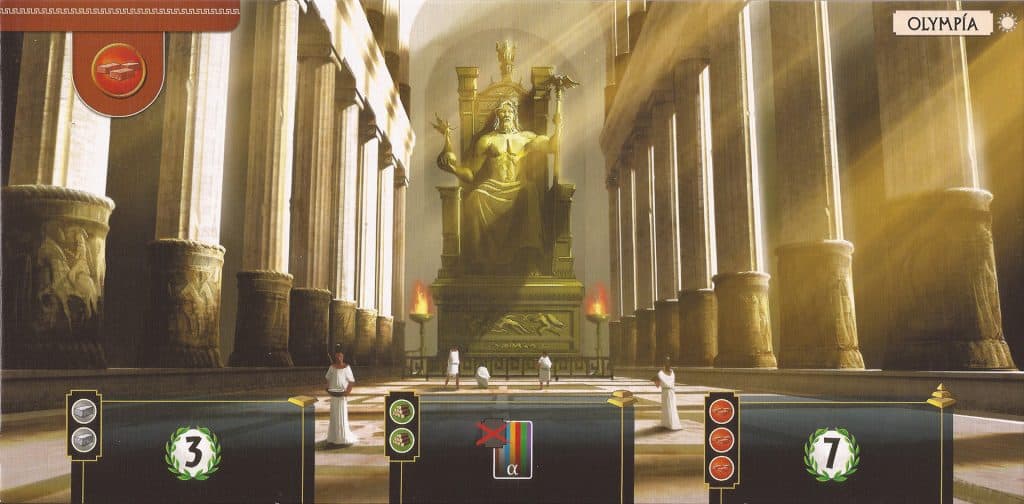
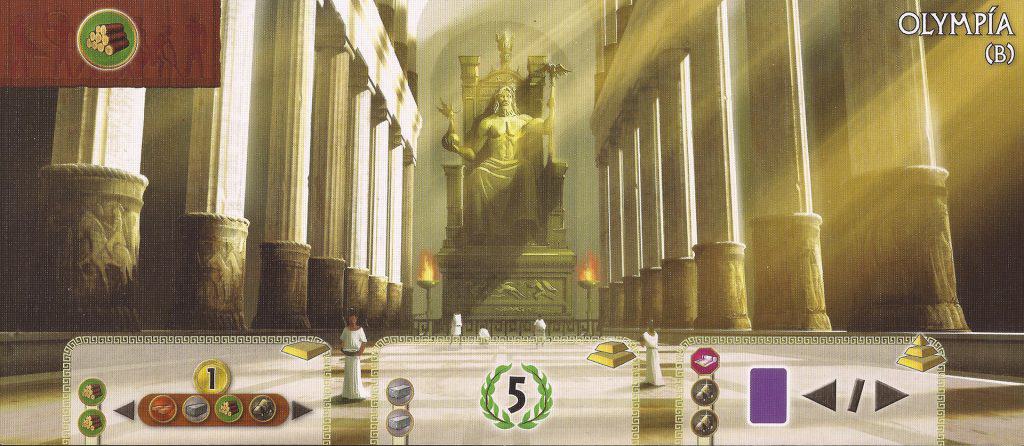
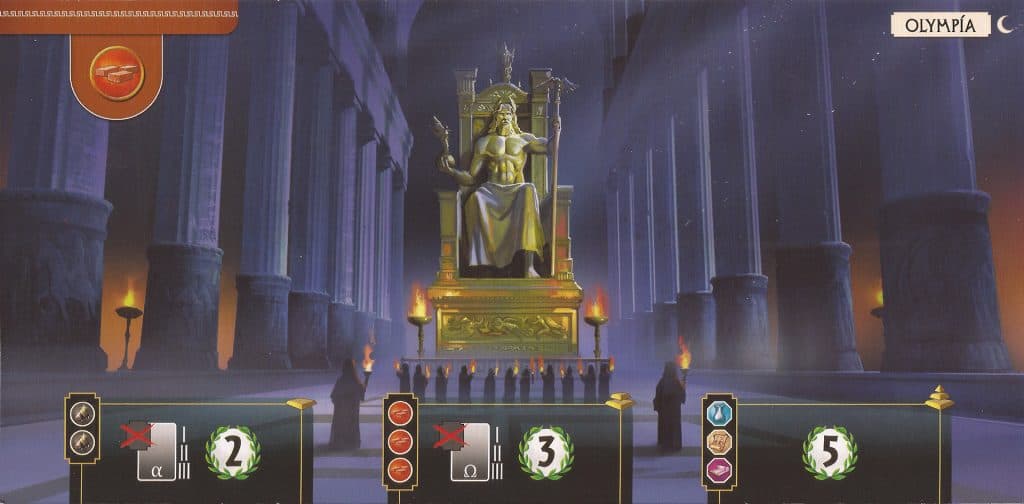
Wow, Olympia’s Wonder was completely gutted and rebuilt from the ground up between editions.
The front side’s 2nd stage ability was likely adjusted to make it easier for the table to keep track of Olympia’s cost reduction effect. Rather than relying on the player to announce when they’re using it, you can easily tell at a glance whether they’re eligible to use it or not by seeing whether they have already built a card of a specific color in their city or not.
If yes, they have to pay to build it. If not, they build it for free. Per the 7 Wonders FAQ, this is tracked over the course of the entire game, not per Age, despite how the rules insert reads, so it does simplify game management a bit and provides a slight buff to the free construction ability overall.
Balance that with slightly higher resource requirements in Stage 3, and this batch of changes makes a lot of sense.
The reverse side’s changes, on the other hand, are honestly worse across the board. I get that the trading post reduction overlaps with both Alexandria and Ephesus. I also understand that copying a guild card can be an incredibly strong point swing.
But honestly, neither of these abilities was backbreaking, and the replacements given in 2nd edition are pretty lackluster by comparison.
The 1st stage of Night side lets you build the first card of each Age for free. Nice, but only good for up to 2 cards. Building the last card of each Age for free in Stage 2 is also useful, as card selection will be poor at that point, but less so than the 1st Stage’s effect much of the time.
Sure you have the potential to build a lot of free cards overall, and getting 10 guaranteed points from the reverse side instead of 5 is nice, but Olympia’s fluid gameplay style gets restricted quite a bit overall in 2nd edition, and much like the nerfs for Ephesus, I’m not clear on why this was necessary.
7 Wonders 1st Edition or 2nd Edition – Which is the Winner?

While both versions of 7 Wonders are excellent games, the polish that can only come from a decade of extensive gameplay gives 2nd edition the clear edge over 1st edition. Both games have a lot to recommend them though.
1st edition’s focus on Wonder building really lets you tap into what your Wonder is capable of as quickly as possible, and I like that it is easier to start games, see the cards, and take cues for building chains from card names rather than symbols you need a flow chart to follow.
2nd edition smooths out the comparative weakness of military strategies and pulls back the power level of Wonders to be more in line with other strategies, creating a better game balance overall. It is also better organized than 1st edition, supplying clearer rules and enough inserts with answers to common questions to meet a table’s needs.
Either way, you can’t go wrong adding this classic board game to your collection.
Board Game Articles You’ll Also Enjoy
- 7 Wonders Full Strategy Guide
- Machi Koro Strategy Guide
- Kingdomino vs. Carcassonne – Which is Better?
- Heroquest vs. Descent – Which Game is Best?
- Lords of Waterdeep Strategy Guide
Braden is a founder of Assorted Meeples and has been a gamer & writer with a vivid imagination all his life. Don’t believe us? Check out his excitement when meeting Goosebumps author R.L. Stine as a kid! An avid Magic: The Gathering spellslinger for over 15 years, you can always convince him to shuffle up for a game (or three!) of Commander.


